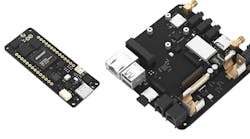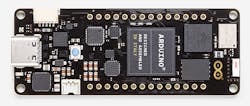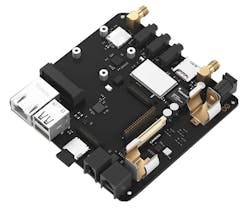The Arduino platform and development tools have built a community and infrastructure for the hobbyist, maker, and educational markets. The readily available chips make it possible to transform a development platform into a product, but that process normally requires board designs and testing that often exceeds the capabilities of the original developers.
Simply turning a design into a product using the existing hardware is impractical for a number of reasons. These can range from reliability of the connections to details like the supported operating temperatures of the components.
The Arduino Portenta H7 (Fig. 1) was announced behind closed doors at this year’s Consumer Electronics Show. It’s designed to address production-quality solutions built around an Arduino platform. The module specification has an industrial temperature range (−40 to 85°C).
The module is based on STMicroelectronics’ (ST) STM32H747 microcontroller, which consists of a 480-MHz Cortex-M7 and a 240-MHz Cortex-M4. The combination delivers 3220 CoreMark/1327 DMIPS of performance. The Cortex-M7 has a 16-kB instruction cache and a 16-kB data cache, and the Cortex-M4 supports ST’s adaptive real-time accelerator (ART) that optimizes flash-memory performance. The chip supports secure firmware install and secure boot.
A pair of 12-bit DACs and three 16-bit, 3.6-Msample/s ADCs are incorporated into the chip. A plethora of serial ports support all popular interfaces—two CAN-FD interfaces, two SDIO interfaces, two USB 2.0 ports with PHYs, and an MDIO slave interface. There’s also a 10/100 Ethernet port along with a camera interface and HDMI-CEC (Consumer Electronics Control) support. An LCD-TFT controller handles display output, and DisplayPort support comes via the USB Type-C connection. The Chrom-ART Accelerator GPU has a dedicated JPEG encoder and decoder, too.
Memory includes 2 MB of flash and 1 MB of RAM, along with 192 kB of tightly coupled memory (TCM). In addition, there’s off-chip support of SRAM, PSRAM, SDRAM and NOR/NAND flash.
On top of that, the Portenta H7 module adds 8 MB of off-chip SDRAM as well as a 16-MB QSPI NOR flash chip. Options are available with up to 64 MB of SDRAM and 128 MB of flash.
Other features include a PHY for the Ethernet port and an NXP SE050C2 EdgeLock secure element. Finally, there’s a wireless module that supports Wi-Fi 802.11 b/g/n and Bluetooth 5.0 with an on-board ceramic antenna. An external antenna can also be used.
Like many compact modules, the chip has a pair of high-density, 80-pin connectors on the bottom. Mounting holes reside on all four corners so that it can be locked down to the carrier board. Its two rows of through-hole, solder connections are more akin to the headers found on other Arduino platforms. These provide access to basic I/O, but not the full functionality that comes with the high-density headers. On the other hand, this is compatible with existing industrial MKR (maker) shields that can be used in development as well.
The module has a USB Type-C connection plus a power connector. Power can also be supplied via the header connections.
A development carrier board (Fig. 2) is available. It includes connectors for the various interfaces such as an SD card slot as well as external antenna connections for wireless support. Most applications will have a custom carrier board design that includes only the peripherals needed for that application.
“By combining the power and flexibility of our production-ready IoT hardware with our secure, scalable, and easy-to-integrate cloud services, we are putting in the hands of our customers something really disruptive,” said Arduino CEO Fabio Violante. “Among the millions of Arduino customers, we’ve even seen numerous businesses transform from traditional ‘one-off’ selling to subscription-based service models, creating new IoT-based revenue streams with Arduino as the enabler. The availability of a huge community of developers with Arduino skills is also an important plus and gives them the confidence to invest in our technology.”
The system comes with Arm mbed support that includes Arm’s Pelion IoT cloud-management system. There’s also the Arduino Pro IoT Cloud, which maintains pricing for developers, makers, and production systems. The Arduino Pro IDE improves on the standard IDE designed for developing larger applications and features support for MicroPython and Javascript in addition to C. In addition, there’s support for TensorFlow Lite for machine-learning applications.
The IDE has GIT support built-in. The tools are also managed via a command line interface (CLI). This allows for integration with third-party tools.
No single module can address all of the computing needs of developers, and the Portenta H7 doesn’t try to address everything either. It provides an impressive set of interfaces and delivers lots of performance with the ability to power down and use very little power. The chip delivers a good migration path from Arduino-based prototypes to production systems without the need to develop a complex circuit board. A carrier board is needed, but this design tends to be significantly easier to create, debug, and maintain.
The module is priced just under $100 in single quantities. Contact Arduino for volume pricing.



